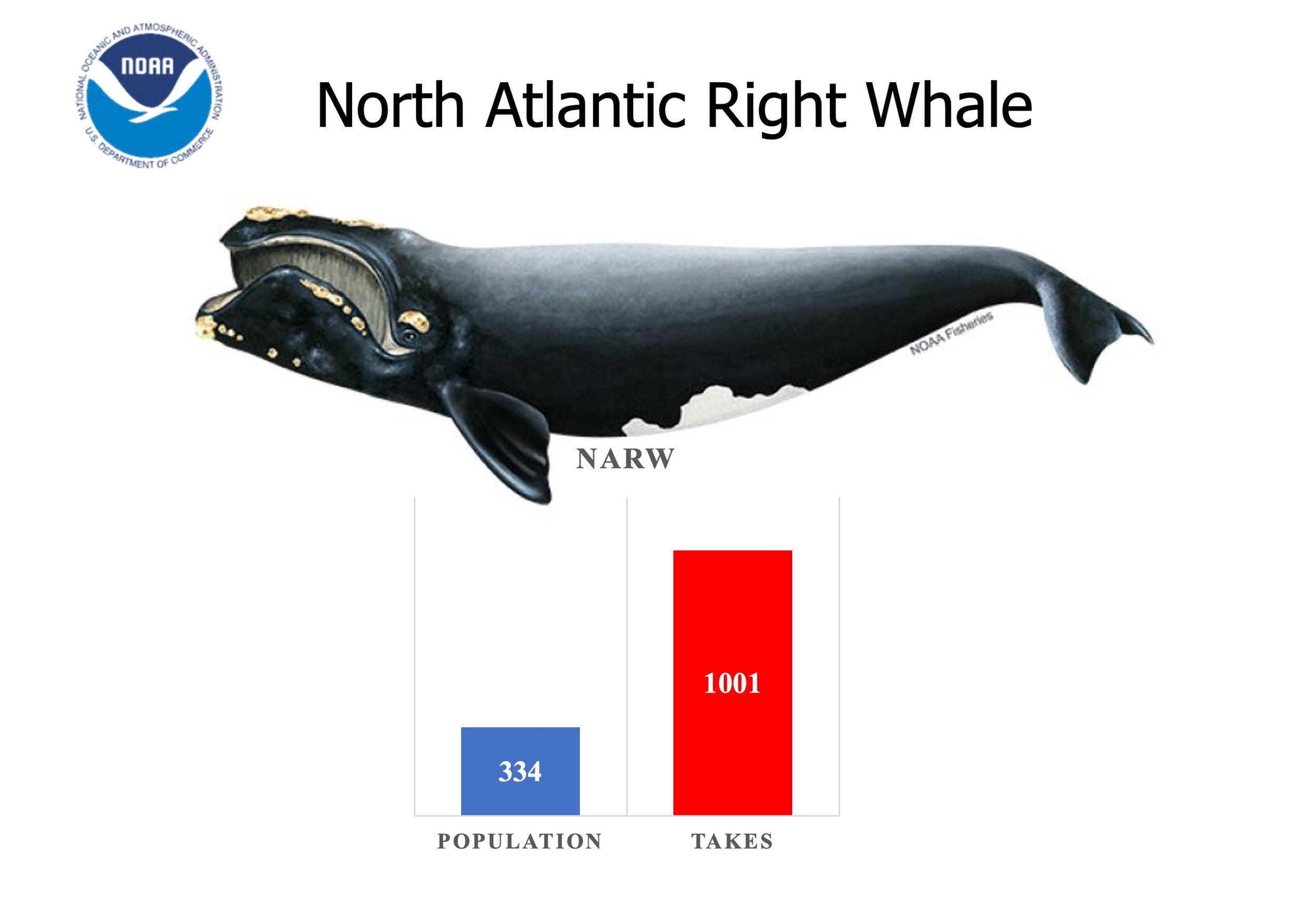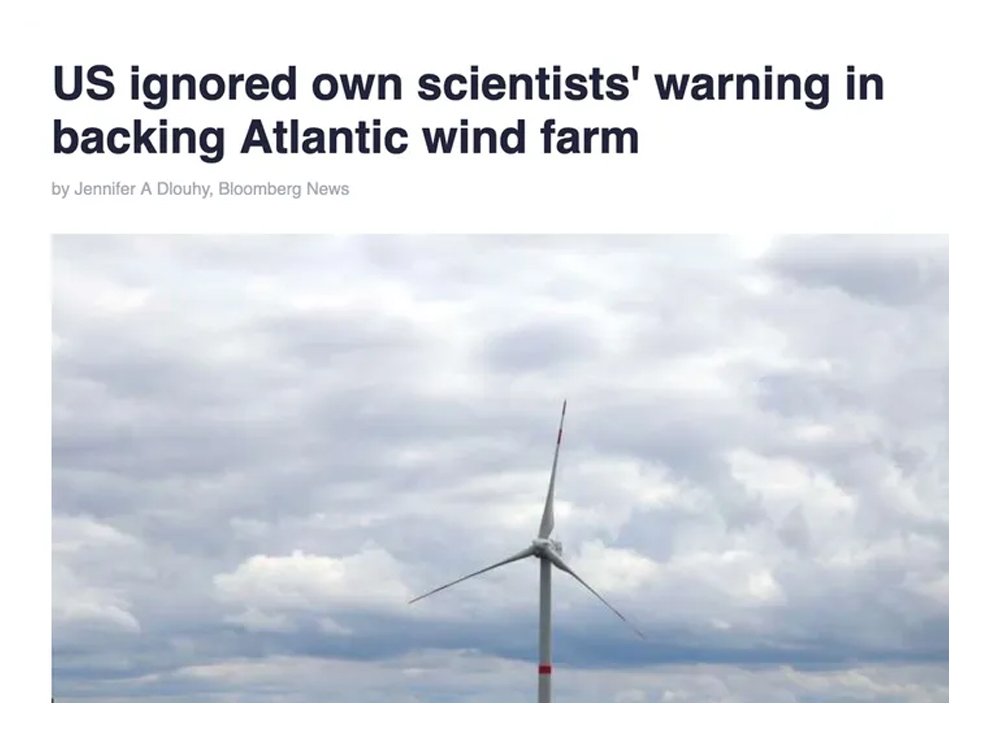Offshore Wind & the Environment
Is Offshore Wind Energy Clean?
34 Million Gallons of Fuels, Oils, Lubricants & Coolants
The Revolution Wind Environmental Impact Statement warns that offshore wind energy projects off the coast of Rhode Island and Massachusetts will house up to 34 million gallons of toxic petroleum products and synthetic coolants and lubricants in our coast. If a hurricane damages these projects, 34 million gallons of toxic oils, fuels, lubricants, and coolants could spill into our coastal waters and wash up on our beaches. Watch our reel here.
Offshore wind energy substations will discharge 8–10 million gallons a day of polluted water.
The SouthCoast Wind project filed for a special discharge EPA permit to dump 8-10 million gallons of chlorinated water heated to almost 90 degrees into the ocean a day. The substations will entrap and kill billions of zooplankton and fish larvae in the open cooling loop. Green Oceans submitted comments to the EPA opposing their permit to allow this. Read the submission here.
Jet Plowing
Trenching and laying the underwater cables generates sediment plumes that choke sea life. This sediment has not been tested for toxic chemicals and yet anything contained in the sediment could contaminate the marine food web and eventually end up in our food supply. Learn more about the dangers of construction here.
Green Oceans Letter to the Rhode Island Energy Facilities Siting Board
Our warning about toxic sediment.
High Voltage Cables: What to Expect
Electromagnetic Fields (EMFs)
Offshore wind energy projects transmit the energy they produce via high-voltage undersea cables. These cables produce electromagnetic radiation. Electromagnetic radiation exposure can cause birth defects in lobsters and other forms of marine life. Many species, from sharks to plankton, use magnetic fields to navigate, orient, find prey and survive. Any EMF larger than the earth’s magnetic fields will disrupt these abilities. Neither the US government nor the wind developers understand the risk of adding high levels of EMFs to a vast region of the US continental shelf and the waterways that connect these projects, such as the Sakonnet River, to onshore substations.
Temperature changes
High-voltage alternating current cables give off significant heat as electricity flows from one point to another. This will raise the temperature of the surrounding water or seafloor, depending on the location of the cable. Even 4 feet away, a cable buried under the ocean floor will warm the surrounding area by 36 degrees Farhenheit.
Human Health
The underwater cables will emit considerable heat and EMFs. Ørsted changed the technical reports from Fahrenheit to Celsius when recording predictions about emitted heat. 20 degrees celsius is 36 degrees Farhenheit. Warming the surrounding area by 36 degrees could have profound effects on the environment. How the heat and EMF levels will affect the environment is largely unknown. No scientific evidence exists to assure us that these levels will not harm the environment or affect human health or the health of marine life.
Green Oceans Letter to the Rhode Island Energy Facilities Siting Board
Our warning about toxic sediment.
Incidental Take Authorizations
Offshore Wind Developers gain permission from NOAA to Harm and Harass Marine Mammals.
20,664
Over 20,000 Whales
NOAA has granted offshore wind developers thousands of Incidental Take Authorizations, the permission to harm and harass marine mammals. The cumulative number of whales exceeds 20,000 “takes.”
Whales are Dying: Is there a link to offshore wind?
Written by Lisa Quattrocki Knight, M.D., Ph.D. and Bill Thompson for Green Oceans.
477,039
Dolphins & Porpoises
More than half a million dolphins.
NOAA divides incidental takes into Level A and Level B. Level A takes include permanent injuries that can lead to death, although death is not necessarily expected. Level B takes indicate NOAA expects the animals will suffer from temporary injury, stress, behavioral changes, or habitat destruction.
Think Twice: Do we want to short-circuit our environmental protection?
Written by Lisa Quattrocki Knight, M.D., Ph.D. for Green Oceans.
100,742
Seals
Over 100,000 seals.
Since the beginning of their offshore wind efforts, the United Kingdom has witnessed an alarming number of marine mammal deaths.
Thousands of marine mammals DEAD on Britain’s beaches—as ‘alarming’ numbers of strandings are recorded…
Written by Jason Endfield on medium.com
Are whale deaths correlated with offshore wind seismic surveys?
Humpback whale deaths are correlated with offshore wind seismic survey activity.
Humpback whale deaths from 2006-2023 were significantly positively correlated with the number of miles (per year) of seismic survey activity in two regions, a polygon that included the central Atlantic States and one that encompassed the southern Atlantic states (R2 = 0.41; F = 23.44; p < .000028; n=36).
— Data provided by Apostolos Gerasoulis, PhD.
Offshore Wind Seismic Survey Activity, not large cargo traffic, correlates with Humpback Whale Mortality
Written by Apostolos Gerasoulis, PhD. and Elizabeth Quattrocki Knight, M.D., Ph.D.
Large Shipping traffic in the NY and NJ ports only minimally correlated with humpback whale deaths.
Large shipping cargo traffic only accounted for a minor percentage (5.6%) of the changes in whale death during the years between 2011-2023 (R2 = 0.057; p < 0.003; n = 153).
— Data provided by Apostolos Gerasoulis, PhD.
NOAA admits offshore wind survey activity correlates with Seismic Activity
Seismic survey activity correlates with humpback whale deaths more than twice as much as shipping traffic.
When the effects of shipping are removed, the correlation between seismic survey miles and whale deaths using monthly data from 2011-2023 remains statistically significant (R2 = 0.13; F = 22.9; p < 0.000005; n = 153), accounting for 13% of the variance. In contrast, shipping traffic accounts for only 5.6%.
— Data provided by Apostolos Gerasoulis, PhD.
Sonar Vessel Noise Survey, May 8, 2023: Technical Report
Rand Acoustics, LLC
Offshore Wind vs Climate Change in Whale Deaths
NOAA has granted more "takes" than the number of North Atlantic right whales alive today.
The North Atlantic right whale is critically endangered, with only 70 remaining reproductively active females and 334 total individuals alive today. Regardless of this critical status, NOAA has granted wind developers over 1000 permissions to harm and harass these whales. This exceeds the size of the entire population.
What does NOAA say?
NOAA admits that not only the construction, but operations during the entire lifespan of the projects could imperil the survival of the North Altantic right whale.
This juvenile fin whale was found stranded on February 29, 2024.
Fin whales are one of the five endangered species that forage in the waters off Rhode Island to survive the winter. Offshore wind construction activity overlaps with their natural habitat. Since offshore wind activity began in 2016, whales have died at an unusually high rate. People who question whether there is an association between offshore wind activity and whale deaths have been silenced by the very people we would expect to help protect these endangered species.
Won’t climate change kill more whales than offshore wind?
Whales evolved over 50 million years ago when the planet’s atmosphere contained twice as much CO2 as it does today and the temperature was more than 10 degrees C (18 degrees F) warmer. Climate change is not killing whales, humans are.
The Harm of Human Generated Noise
Should we worry?
Yes. Humpback, minke, and north Atlantic right whale deaths have all significantly increased since the onset of offshore wind construction and seismic survey activity. Here is a picture of either a humpback or a fin whale floating in front of the SouthFork Construction site in September, 2023.
Was construction work occurring at the time?
Yes. The Ørsted Mariner's briefing for that week in September stated that construction was occurring at that site (see area in red) directly around the turbine foundation behind the dead whale (AN09).
Why did we have to file a Freedom of Information Act request to track down the whale?
An extensively decomposed dead humpback whale washed up on Block Island's southern beach several days later. NOAA kept the incident from the public. We filed a Freedom of Information Act (FOIA) to obtain the police report that verified the death.
Why does Coxes Ledge matter?
What happened?
Back in 2012, Jack Reed, Sheldon Whitehouse, and Save the Bay all declared Coxes Ledge safe from offshore wind development. The removal of Coxes Ledge from the Wind Energy Leasing Area was touted as a victory for RI fishermen. What happened? Who let this happen? And why did our politicians abandon Rhode Island’s fishermen?
Spawning Grounds & Foraging Habitat
Coxes Ledge is one of the only remaining spawning grounds for Southern New England Cod and a winter foraging region for 5 endangered whale species. NOAA has designated Coxes Ledge and the surrounding Wind Energy Lease area a Habitat Area of Particular Concern. The black X’s mark the turbines Ørsted removed to “protect” Coxes Ledge. Clearly, Coxes Ledge turbines and inter-array cables still cover almost the entire area of Coxes Ledge.
Atlantic Cod
Siting offshore turbines and the accompanying inter-array cables on Coxes Ledge will destroy this fragile ecosystem and will threaten the survival of Southern New England Cod. Cod loyally return to the same spawning grounds each year to breed. If their normal grounds are altered and can no longer support spawning, they will not know where to relocate. The noise of both the construction and the operation of the wind projects on Coxes Ledge may threaten the survival of this species.
Spawning Dynamic and Associated Management Implications for Atlantic Cod
Zemeckis et al., 2014.
NOAA Warned BOEM
Scientists at NOAA have repeatedly warned BOEM, the government agency responsible for permitting offshore wind projects, that constructing offshore wind on Coxes Ledge could drive Atlantic cod to extinction. Yet, BOEM has repeatedly ignored their warnings.
BOEM Ignores NOAA
BOEM ignores the risk to cod and permits both projects on Coxes Ledge regardless of NOAA's concerns.
US Ignored Own Scientists' Warning in Backing Atlantic Wind Farm
By Jennifer A Dlouhy, Bloomberg News
Save Coxes Ledge
We now have over 3,200 signatures to save Coxes Ledge, but we would like more. Please distribute the link to family, neighbors, and friends to help gather more signatures.
Will offshore wind harm endangered birds?
The blades are deceptively fast, traveling at an average speed of 150 mph at the tips.
They pose a serious threat to birds and bats.
Source:
Wind Turbines: Threat to National Treasure of the Great Lakes
The endangered Piping Plover, a native to Rhode Island, will be in harm's way.
The Rhode Island wind projects will occupy a portion of the Atlantic flyway, a major migration route for thousands of birds.
Offshore wind turbines’ wind wake effects.
Offshore Wind Energy Could Alter Ocean Currents
Generating wind power at sea may disturb ocean currents and marine ecosystems, according to a new study.
Source: www.nbcnews.com/id/wbna27681666
Could federal wind farms influence continental shelf oceanography and alter associated ecological processes? A literature review.
Miles, T. et al., Science Center for Marine Fisheries and Rutgers School of Environmental and Biological Sciences, 2020.
Wind Power Affects Local Climate
Wind turbines generate turbulence that can extend for over 45 miles. Harvard Scientists recognized that on land, wind turbines significantly raise local temperatures.
Wind Projects Raise Local Temperatures
Miller & Keith, Joule 2, 1–15
Offshore Wind Turbines Create Long-Lasting Sediment Plumes
Currents and tides interact with turbine foundations to create turbulence and sediment plumes. This effect could alter water temperature stratification and plankton growth. Some scientists are concerned about unknown effects on the hydrodynamics of the ocean.
Offshore wind projects can alter large-scale ocean hydrodynamics.
Nils Christiansen, Ute Daewel, Bughsin Djath and Corinna Schrum






























